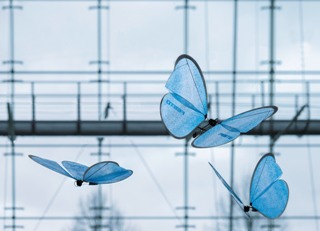Oct 6 2015
At Motek 2015 from 5th to 8th October in Stuttgart, Festo presents current research projects from the Bionic Learning Network.
 Coordinated flying thanks to indoor GPS: with the eMotionButterflies, Festo now combines the ultra-lightweight construction of artificial insects with coordinated flying behaviour in a collective. (Photo: Festo AG & Co. KG)
Coordinated flying thanks to indoor GPS: with the eMotionButterflies, Festo now combines the ultra-lightweight construction of artificial insects with coordinated flying behaviour in a collective. (Photo: Festo AG & Co. KG)
At Motek 2015, the 34th International trade fair for automation in production and assembly from 5th to 8th October in Stuttgart, Festo presents current research projects from the Bionic Learning Network. The FlexShapeGripper and the eMotionButterflies are inspired by natural principles and demonstrate ways to transfer those to automation.
Nature offers a variety of intelligent solutions to technical problems that have been optimized through continuous improvement. Those principles inspire the engineers of the Bionic Learning Network to transfer them to questions of automation technology.
“What we need to do is simplify the challenges involved in production sequences and guarantee intuitive control of machines and plants,“ says Dr.-Ing. Heinrich Frontzek, Head of Corporate Communication and Future Concepts at Festo. As a global manufacturer of pneumatic and electric automation technology, Festo shapes the production and working environments of the future and offering its customers innovative solutions for the production systems of tomorrow. “The current projects from Festo’s Bionic Learning Network provide visionary approaches on how to do this,” emphasises Mr. Frontzek.
FlexShapeGripper – gripping modelled on the chameleon’s tongue
Gripping applications have always played a key role in production. Festo already developed various grippers – like the MultiChoiceGripper from 2014, whose adaptive fingers flexibly and smoothly adapt to different forms. The adaptation to various objects is continued with the FlexShapeGripper, whose working principle is derived from the tongue of a chameleon. Chameleons use their tongues to catch insects. Once the chameleon has sighted its prey, it rapidly shoots out its tongue like an elastic band. The captive insect then adheres to it and is drawn in as on a fishing line. The FlexShapeGripper can pick up, gather and set back down several objects with the widest range of shapes in one procedure – without the need for a manual conversion. This is made possible by its water-filled silicone cap, which wraps itself around the items being gripped in a flexible and form-fitting manner. The unique inherent ability to adapt to different shapes gives the FlexShapeGripper its name. Both the holding and the release mechanism are triggered pneumatically. No additional energy is necessary for the holding process. In future, the FlexShapeGripper could be used in any facility where multiple objects with a range of different shapes are handled at the same time – for example in the service robotics sector, for assembly tasks or when handling small parts. The bionic model demonstrates solutions for new gripper technologies using pick and place operations as well as the flexibility and adaptability of production. Currently Festo is in dialogue with interested customers to test the market relevance of this prototype.
eMotionButterflies: ultralight flying objects with collective behaviour
The bionic butterflies with an aesthetic appeal illustrate complex topics from the future world of production, such as functional integration, ultra-lightweight design, and above all networked communication between individual systems that is optimised on a real-time basis. The coordination between the individual flight objects is autonomously and reliably enabled by a well-networked external guidance and monitoring system. The communication and sensor technology used, which constitutes an indoor GPS system, ensures collision-free collective behaviour of the butterflies. The combination of integrated electronics and external camera technology with a host computer makes for process stability thanks to an intelligent guidance and monitoring system. The onboard electronics system allows the individual wing pairs to be precisely addressed; it includes its own inertia sensors for the purpose of regulation. No human pilot is therefore required to control the eMotionButterflies. Preprogrammed routes, which specify the flight paths for the butterflies during their manoeuvres, are stored on the central computer. With the aid of additionally stored behaviour patterns, however, they can also move autonomously through the space. With the eMotionButterflies and the indoor GPS derived from it, Festo addresses aspects of the automation of the future, such as the safe and intuitive interaction between man and machine or the autonomous and adaptable behaviour of technical systems, which permit controlled interventions by people at any time and hence create new prospects for the workspace of the future.
You will find the Bionics exhibits from Festo at stand 8410 in hall 8. Flight demonstrations with the eMotionButterflies take place every hour.